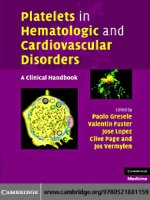052180311X cambridge university press human frontiers environments and disease jul 2001
Bạn đang xem bản rút gọn của tài liệu. Xem và tải ngay bản đầy đủ của tài liệu tại đây (3.74 MB, 431 trang )
MMMM
This page intentionally left blank
Human frontiers, environments and disease
This compelling account charts the relentless trajectory of humankind and its changing survival patterns across time and landscape, from when our ancestors roamed the African savannah to today’s
populous, industrialised, globalising world. This expansion of human frontiers – geographic, climatic,
cultural and technological – has entailed many setbacks from disease, famine and depleted resources.
The changes in human ecology due to agrarianism, industrialisation, fertility control, social modernisation, urbanisation and modern lifestyles have profoundly affected patterns of health and
disease. Today, while life expectancies rise, Earth’s ecosystems are being disrupted by the combined
weight of population size and intensive consumption. The resultant climate change, stratospheric
ozone depletion, loss of biodiversity and other environmental changes pose risks to human health,
perhaps survival. Recognising how population health, long term, depends on environmental conditions, can we achieve a transition to sustainability?
Whilst the canvas that Tony McMichael covers is vast, the detail he brings to bear on this immense
subject is both illuminating and dramatic. This account succeeds on many levels: as a chronicle of
human colonisation and environmental impact; as a description of how recent technological changes
have induced mismatches between our biological needs and our ways of living; and as an analysis of
our rapidly changing demographic and social profile and its environmental and health consequences.
As Tony McMichael argues in the Preface, ‘Humankind is now treading heavily upon the Earth. We
have greatly increased the size of our “ecological footprint”. As we perturb Earth’s life-support
systems, so we endanger the prospects for human population health and survival. The trail cannot
continue much longer with footprints like these.’
Tony (A.J.) McMichael is Professor of Epidemiology, London School of Hygiene and Tropical
Medicine. He has held positions in Australia, USA and UK, and has taught widely in Asia, Africa and
Europe. He has advised WHO, UNEP, the World Bank and Intergovernmental Panel on Climate
Change on dietary, environmental and climatic influences on health. He has enthusiasms for
palaeoanthropology and social history. His previous book published by Cambridge University Press
in 1993 was Planetary Overload (ISBN 0 521 55871 9), a widely acclaimed and influential account of
global environmental change and health of the human species.
Human frontiers,
environments
and disease
Past patterns, uncertain futures
Tony McMichael
The Pitt Building, Trumpington Street, Cambridge, United Kingdom
The Edinburgh Building, Cambridge CB2 2RU, UK
40 West 20th Street, New York, NY 10011-4211, USA
477 Williamstown Road, Port Melbourne, VIC 3207, Australia
Ruiz de Alarcón 13, 28014 Madrid, Spain
Dock House, The Waterfront, Cape Town 8001, South Africa
© Anthony J. McMichael 2004
First published in printed format 2001
ISBN 0-511-03265-X eBook (Adobe Reader)
ISBN 0-521-80311-X hardback
ISBN 0-521-00494-2 paperback
Central theme
Humankind’s long evolutionary and historical experience shows how the social and
natural environments affect patterns of disease and survival. Appreciating this ecological
perspective on human population health – at a time when large-scale stresses are
appearing in our world – is a prerequisite to achieving a sustainable future.
Some comments on Human frontiers, environments and disease
‘This impressive book by an eminent public health scientist explores our most important
relationship: our interaction with the environment. It is essential reading for all concerned with
assuring future human health – and our very survival.’
Robert Beaglehole Professor of Community Health, University of Auckland
‘This book achieves an unusual and important synthesis of the large-scale evolutionary, social
and environmental influences on human health and survival. This ecological perspective,
highlighting the history of disease and wellness, the state of our epidemiological environment,
and the general impacts of recent cultural trends on well-being, is essential if we are to
achieve a sustainable future.’
Paul R. Ehrlich Bing Professor of Population Studies, Stanford University, and author of
‘Human Natures’
‘Human Frontiers, Environments and Disease is an innovative and constructive analysis of a
problem fundamental to mankind, past, present and future. No one concerned with the
bio-medical prospects of the human race could fail to find Professor McMichael’s accomplished
account thought-provoking and eye-opening.’
Roy Porter The Wellcome Trust Centre for the History of Medicine at University College
London
‘This is a splendidly written book – a revelation about human health over the millennia. From
yellow fever to hypertension it underscores the larger framework of environment-health links.
We will be better able to handle the future if more people read this insightful book.’
Thomas E. Lovejoy Smithsonian Institution, Washington, DC
‘Today, worldwide, most people live longer and are better fed than ever before. These
benefits, however, have environmental and other costs. Tony McMichael’s book gives a well
organised and wide ranging account of this human story and of its ecological underpinnings.
The book concludes with a clear-eyed analysis of current threats to sustainability.’
Sir Robert May President, The Royal Society
To Judith
for lives shared
Contents
List of sources for illustrations
Preface
page viii
xi
11
Disease patterns in human biohistory
12
Human biology: the Pleistocene inheritance
30
13
Adapting to diversity: climate, food and infection
58
14
Infectious disease: humans and microbes coevolving
88
15
The Third Horseman: food, farming and famines
123
16
The industrial era: the Fifth Horseman?
152
17
Longer lives and lower birth rates
185
18
Modern affluence: lands of milk and honey
220
19
Cities, social environments and synapses
250
10
Global environmental change: overstepping limits
283
11
Health and disease: an ecological perspective
318
12
Footprints to the future: treading less heavily
341
Notes
Index
366
403
vii
1
Sources for illustrations
Figure 1.1
Figure 1.2
Figure 1.3
Figure 1.4
Figure 2.2
Figure 3.1
Figure 3.2
Figure 3.3
Figure 4.1
Figure 4.2
Figure 4.3
Figure 5.1
Figure 5.2
Figure 5.3
Figure 6.2
Figure 7.1
Figure 7.2
viii
Data from: WHO. World Health Report. Making a Difference. Geneva: WHO, 1999.
page 3
Modified and updated from: Secretary of State for Health. Savings Lives: Our Healthier
Nation. London; HMSO, 1999.
5
Data from: OECD. Health Data 2000: A Comparative Analysis of 29 Countries (CD rom).
Paris: OECD, 2000.
23
Source: Leon D and Shkolnikov V, unpublished data.
26
Source: Courtesy of the Bernard Price Institute for Palaeontological Research, University
of the Witwatersrand.
45
Modified from: Cavalli-Sforza LL, Piazza A, Menozzi P. Demic expansions and human
evolution. Science 1993; 259: 639–46; Solbrig OT, Solbrig DJ. So Shall You Reap.
Washington, DC: Island Press, 1994.
65
Photograph by Dan Salaman.
72
Source: Library, London School of Hygiene and Tropical Medicine.
82
Photograph by James Harris (reprinted from: Cockburn A, et al. (eds.) Mummies,
Diseases and Ancient Cultures. Cambridge University Press, 1998).
105
Source: The Cambridge Encyclopaedia of Human Evolution, 1992, p. 415.
109
Source: The Wellcome Institute for the History of Medicine, London.
111
Graph prepared by Tim Osborn, Climatic Research Unit, University of East Anglia, UK.
129
Sources: Eaton SB, Konner MJ. Paleolithic nutrition: a consideration of its nature and
current implications. New England Journal of Medicine 1985; 312: 283–9; Nestle M.
Paleolithic diets: a sceptical view. Nutrition Bulletin 2000; 25: 43–7.
134
Courtesy of the Department of Biological Anthropology, University of Cambridge.
Photo: Gwil Owen.
139
Modified from: Delmas RJ, Legrand M. Trends recorded in Greenland in relation with
Northern Hemispheric anthropogenic pollution. IGBP Global Change Newsletter No. 36
(December), 14–17.
163
Data from: UN Population Division. World Population Prospects: The 1998 Revision.
New York: United Nations, 1998.
191
Based on data in: Wills C. Plagues. Their Origin, History and Future. London:
HarperCollins, 1996, pp. 40-6; Bonneux L, Barendregt JJ, Van der Maas PJ. The expiry
date of man: a synthesis of evolutionary biology and public health. Journal of
Epidemiology and Community Health 1998; 52: 619–23.
195
ix
List of sources for illustrations
Figure 7.3
Modified from: Southwick CH. Global Ecology in Human Perspective. Oxford: Oxford
University Press, 1976.
Based on data in: World Cancer Research Fund. Diet, Nutrition and the Prevention of
Cancer: A Global Perspective. London: WCRF, 1997.
Based on data from: Ministry of Agriculture, Fisheries and Food (UK). Household Food
Consumption and Expenditure (Annual Reports, 1940–99). London: HMSO, 1940–94.
Based on data from: International Obesity Task Force. Obesity: Preventing and
Managing the Global Epidemic. Geneva: WHO, 1998.
Based on data in: Marmot M. Improvement of social environment to improve health.
Lancet 1998; 351: 57–60.
Based on data from: World Bank. World Development Report 2000/2001. Attacking
Poverty. Oxford: Oxford University Press, 2000, Tables 1, 2.
Based on data from: WHO. Health for All Data Base (2000). Copenhagen: WHO
European Regional Office.
Developed from a simpler model in Vitousek P, et al. Human domination of Earth’s
ecosystems. Science 1997; 277: 494–9.
Modified from: McMichael and Powles, Human numbers, environment, sustainability
and health. British Medical Journal, 1999; 319: 977–80.
Based on data from: Climatic Research Unit, University of East Anglia, UK and Working
Group I, Intergovernmental Panel on Climate Change. Third Assessment Report. Geneva:
World Meteorological Organization, 2001.
Modified from: Hales S, Kovats S, Woodward A. What El Niño can tell us about human
health and global climate change. Global Change and Human Health 2000; 1: 66–77.
Modified from: Butler CS, et al. Globalisation and environmental change: implications
for health and health inequalities. In: Eckersley R, Dixon J (eds.), The Social Origins of
Health and Well-being: From the Planetary to the Molecular. Cambridge: Cambridge
University Press, in press; Loh J, et al., Living Planet Report. London: Earthscan, 1998.
Figure 8.1
Figure 8.2
Figure 8.3
Figure 9.1
Figure 9.2
Figure 9.3
Figure 10.1
Figure 10.2
Figure 10.4
Figure 10.5
Figure 12.1
214
224
233
238
268
275
278
285
287
298
301
345
Preface
Human life expectancy, in the space of a mere century or so, has become much
longer than ever before. This primarily reflects the improved social and physical conditions of living, along with the strengthening of civil institutions; circumstances which, in particular, have greatly diminished childhood deaths
from infection and malnutrition. We have thus partially reined in two of the
four biblical Horsemen of the Apocalypse: Famine and Pestilence on their black
and pale horses, respectively.1 Meanwhile, the other two Horsemen, War and
Conquest, still roam menacingly on their red and white steeds.
Warfare continues. The recent conflicts in Kosovo, Chechnya and Sierra
Leone testify to the destructiveness of modern firepower and the attendant toll
in civilian casualties. Conquest persists, albeit mostly in modern commercial
guise, reflecting aspects of economic globalisation and deregulated trade. The
ascendancy of free markets, while conferring some health gains via material
improvements and the restoration of dietary diversity, adversely affects the
health of many vulnerable populations. Our modern economic system has
widened the rich–poor gap and, in many settings, has weakened social institutions, eroded environmental conditions, fostered exploitative labour practices
and displaced peasant farmers onto more marginal land. Meanwhile, in the
world’s expanding cities, commercial pressures promote cigarette smoking,
automobile dependency and the consumption of energy-dense processed foods.
The profile of human health remains mixed.2 The health of the wealthy and
fortunate continues to exceed that of the poor and disadvantaged, both
between and within countries. New diseases emerge alongside the old as societies change, as urbanisation proceeds, and as life expectancy rises. Further, we
face various unfamiliar large-scale risks to health.3 Changes in human demography and mobility, and heightened environmental disruption, have contributed to increases in both new and resurgent infectious diseases.
Meanwhile, nature’s food-producing resources and fresh-water supplies, now
under great pressure, must somehow suffice for a world population that has
rising material expectations and is likely to increase from 6 billion to 9 billion
xi
xii
Preface
by 2050. More generally, the increasing impact of human economic activity on
Earth’s atmosphere, oceans, topsoil and biodiversity is weakening the planet’s
life-support systems, changing the climate, and thereby casting a long shadow
over humankind’s future prospects.
Even so, our health indices are generally improving. Infant mortality has
fallen markedly in most populations in response to gains in nutrition, female
literacy, family planning, sanitation and vaccination. Modern medicine is
increasingly able to defer death, if not always to maintain or restore good
health. Epidemiologists continue to whittle away at identifying the factors that
contribute to the causation of each specific disease, thereby facilitating its prevention. Meanwhile, on the horizon looms the prospect of disease prevention
or alleviation by genetic engineering.
How can we explain this seeming paradox of extended life expectancy in an
increasingly environmentally stressed world? Optimists might argue that our
improved social institutions and technological capacities can more than compensate for this ‘external’ environmental decline. Meanwhile, ecologically
attuned scientists suspect that we have achieved better population health substantially via material advances that have eroded natural environmental capital
– that, in Tim Flannery’s words, we have been ‘future eaters’.4 In all other
species, sustained population health depends on the continuation of natural
processes that yield energy, nutrients and fresh water. This life-supporting ‘dividend’ from nature is consumed on a recurrent basis, leaving nature’s capital
stock essentially intact. Human populations, however, have become increasingly dependent upon consuming that natural capital, a process that has now
culminated in unprecedented global environmental changes. Those changes
pose risks to the health of future generations.
We can understand the significance of these emerging large-scale influences
on human health best within an ecological framework. Such a framework elucidates the evolutionary, historical and cultural dimensions of the patterns of
human health, disease and survival. We forfeit much understanding of the determinants of health and disease unless we can stand back and consider how the
changing conditions of life, the collective experiences of whole populations over
time, shape the larger patterns of health and survival. This means extending
beyond the recent focus of epidemiologists on an individual-based ‘biographical’ account of disease risk – that is, a risk that is the product of itemised personal behaviours, exposures and biomedical characteristics. Rather, we should
apply a more integrative approach of a kind that, during the twentieth century,
was largely overshadowed by the reductionist ideas inherent in the classic germ
xiii
Preface
theory and the ensuing biomedical model; an approach which must now engage
with the often naive determinism of ‘post-genome’ molecular genetics.
distinctive, yet inter-related, features in this long history
of the changing patterns of human ecology and disease. They are: (i) the
encountering by human societies, over time, of many new environmental
hazards; (ii) the recurring tensions between changes in living conditions and
the needs and capacities of human biology; and (iii) in recent times, the
impacts upon patterns of health and disease of population ageing and urban
living. These important transitions each deserve a few more introductory
words. They encapsulate the unusual, evolving experiences of health and
disease in a uniquely dominant, environmentally invasive, species.
First, human populations have colonised, adapted to and ultimately
changed many of the world’s regional environments. As our Homo sapiens
forebears dispersed out of Africa from around 80,000 years ago, they encountered unfamiliar types of infections, foods and physical hazards. The particularities of those environments induced cultural and, in some cases, genetic
adaptations. Social and technological adaptation has been the real key to
global colonisation, enabling humans to increase the ‘carrying capacity’ of
local environments. These changes in human ecology and living conditions
also changed the spectrum of diseases. Agriculture and settled living, originating a brief 10,000 years ago, increased the local food yield. As staples came to
predominate, agrarianism reduced the range of dietary nutrients and incurred
risks of occasional famines. Settled human living, in close proximity with livestock, created unprecedented new ecological opportunities for microbes to
adapt to and colonise humans. Hence the emergence of measles, smallpox,
tuberculosis and so on. Subsequently, military, commercial and colonial contacts amplified the spread of these infectious diseases. Much later, industrialisation brought new material wealth, various localised environmental hazards,
occupational diseases, and the health impacts of modern transport systems.
The subsequent generalisation of more ‘affluent’ ways of living within developed countries consolidated the health gains that had followed the retreat of
infectious epidemics – but at the price of acquiring various chronic noncommunicable diseases of late adulthood, particularly those associated with
dietary imbalances, physical inactivity and tobacco. Heart disease, peaking in
late twentieth century, became the hallmark of modern Western societies, even
as infectious disease continued to account for almost half the deaths in the
world’s poorest populations.
xiv
Preface
Second, the increasing rapidity and intensity of technological change,
urbanisation, material consumption and migration in recent centuries has
heightened various mismatches between the biological attributes of humans
and their living environment. Some of these mismatches influence the occurrence of particular diseases. For example, the advent of abundant energy-dense
foods in increasingly physically inactive urban populations, and the resultant
obesity, is causing a worldwide surge in diabetes. The sickle-cell trait in African
Americans no longer confers benefit in the absence of malaria, but it does
cause pain and suffering. Skin cancer rates are greatly elevated in fair-skinned
people of northern European ancestry living now at more sun-exposed latitudes in Australia, New Zealand and the southern USA.
Third, the human demographic profile is now changing dramatically as
numbers increase, as urbanisation gathers pace, and as life expectancy extends
well beyond our reproductive years. We will thus incur considerably more
chronic disability and disease than occurs in other animal species, most of
whose members do not survive beyond middle adulthood. We face a social
future in which a much greater proportion of the population is elderly, and in
which patterns of community and family support differ markedly from historical traditions.
On the horizon, meanwhile, are two other momentous developments. Each
has far-reaching consequences for human population health. At the microscale we are revealing, intentionally, nature’s molecular secrets; we are learning
about our genetic code and beginning to rearrange genetic structures. At the
macro-scale, as mentioned above, we are unintentionally overloading Earth’s
life-supporting systems. We have already modified the social, material and
environmental foundations of human health over the past two centuries,
much of it for the good. Today, as human intervention in the global environment and its life processes intensifies, we need better understanding of the
potential consequences of these ecological disruptions for health and disease.
These insights should then guide our search for sustainable ways of living.
I explore the story of how changes in human biology, culture
and the surrounding environment have influenced patterns of health and
disease over many millennia. I offer a narrative account of the evolution of
human biology, society, environmental impact and ways of living and how
those have affected patterns of health. The message is that the health of populations is primarily a product of ecological circumstance: a product of the interaction of human societies with the wider environment, its various ecosystems
xv
Preface
and other life-support processes. Within the larger scheme of things, human
health and survival depends on our maintaining a functional ecosphere that
can continue to support human biological and social needs.
A metaphor that illuminates the ecological dimension of human population
health is that of our species’ ‘footprints’: our footprints along the trail of biohistory. Four types of footprints lead from our distant past into today’s world,
and then on into an uncertain future.
First, we have a wonderful reminder of the evolutionary trajectory of our
hominid ancestors in the mud-preserved Laetoli footprints. These were the footprints, from 3.5 million years ago, of a little band of three upright-walking australopithecines in the African savannah of Laetoli Gorge, Tanzania. The height
of these australopithecines was two-thirds that of modern humans; their brain
capacity was one-third of ours. Their toes were still a little curved; they were predominantly vegetarians; their communications probably lacked syntax; and
adult sexual pair-bonding may have been tentative and temporary. But here, in
these footprints, were pointers to the eventual physical, cognitive and emotional
attributes of the hominines, the successors to the australopithecines. These, in
retrospect, were footprints wandering into the human future.
Second, as these early hominids responded to local environmental changes
and the pressures of competition for food within their African environment,
so their biology evolved. The brain enlarged; the anatomy of the gut changed;
the metabolic handling of altered diets adapted; and skin, hair, stature and
blood-vessel tone were all modulated in response to climatic shifts. Similar
genetic adaptation occurred in response to regional diets and, later, the adoption of agrarianism. Successful biological adaptations were preserved in genes,
to be passed to future generations. Today, various of those genetic adaptations
affect our susceptibility to certain diseases, especially in situations of markedly
altered ways of living. Those genetic adaptations are molecular footprints that
reach from our past into the present and future.
Third, the capacity for cumulative culture enabled humans to leave their
primordial evolutionary patch. From around 80,000 years ago, the modern
human species, Homo sapiens, spread from Africa to West Asia, then SouthCentral Asia, Australia, East Asia, Europe, North America and so on. The footprints of this global diaspora remain in many forms: stone tools, fire-hearths
and permanently modified local environments. Those are our species’
palaeoanthropological footprints across the landscape of time and place.
And what of that future? Humankind is now treading very heavily upon the
Earth. We have greatly increased the size of our ‘ecological footprint’.5 We used
xvi
Preface
ten times more energy in the twentieth century than our ancestors used in the
previous thousand years.6 As we perturb Earth’s life-support systems, such as
the climate system and the stocks of biodiversity, so we endanger the prospects
for human population health and survival. The trail cannot continue much
longer with footprints like these. Yet we cannot reverse, and need not apologise
for, human dominance over other species and the environment at large.
Humans, after all, are a part of nature. We are a species that, by evolutionary
happenstance, has the unique capacity to transform and control the natural
world. But we must find a way of living within the limits of this essentially
closed biophysical system, Planet Earth. To this end we must now redirect our
wonderfully inventive and versatile brains – to date, the most distinctive
product of hominoid evolution. Otherwise the hominid chapter in life’s grand
evolutionary narrative may end unhappily.
, and on a happier note, I must acknowledge the many and
diverse persons who have directly and indirectly assisted me in writing this
book. Various colleagues at the London School of Hygiene and Tropical
Medicine have been a rich source of ideas and critical comment. These include
in particular Dave Leon, Simon Strickland, Astrid Fletcher, David Bradley, Paul
McKeigue, John Cleland, Prakash Shetty, Sari Kovats, Andrew Haines, Virginia
Berridge, Andy Hall, Emily Grundy, Pat Doyle, Lucy Pembrey, Chris Curtis and
Paul Fine. Other colleagues from outside the School whose ideas and suggestions I have appreciated include John Powles, Kirk Smith, Bill Rees, George
Davey Smith, Nancy Krieger, Alistair Woodward, Tord Kjellstrom, Jack
Caldwell, Robert Beaglehole, Kris Ebi, Philip McMichael, Neil Pearce, Peter
Newman, Ruth Bonita, David Waltner-Toews, Leslie Aiello, Laura Westra,
Norman Myers, Paul Ehrlich, David Rapport, Paul Epstein, Steve Kunitz, Paolo
Vineis, Jonathan Patz, Pim Martens, Maurice King, Tim White and Colin
Butler. My thanks to Phillip Raponi for typing the rather arduous final round
of revisions, and to Peter Silver my editor at Cambridge University Press – both
for his encouragement and for his understanding that a busy academic life does
not permit books to be written by the agreed date, or even soon thereafter. My
wife, Judith, immersed in her own writing commitments, has known that it
meant much to me to finish this book. We will find more weekend time in
future to tread lightly on the countryside.
1
Disease patterns in human biohistory
We are living through an unprecedented transformation in the pattern of
human health, disease and death. There have been many great episodes of pestilence and famine in local populations over the ages, but there has been
nothing as global and rapid as the change in the profile of human disease and
longevity over the past century or so. For hundreds of thousands of years as
hunter-gatherers, and subsequently in agrarian societies, our predecessors had
an average life expectancy of approximately 25–30 years. Most of them died
from infectious disease, and many died of malnutrition, starvation or physical
trauma. A large proportion died in early childhood. Today, for the world as a
whole, average life expectancy is approaching the biblical ‘three score years and
ten’, and in some rich countries it has reached 80 years.
Two immediate questions arise. What has caused this radical shift in health
profile? Can future health gains be shared more evenly around the world?
During the 1990s, the combined burden of premature death and chronic or
disabling disease was about four times greater, per 1,000 persons, in subSaharan Africa than in the Western world.1 An even more important question
looms in a world that is undergoing rapid social and environmental change:
can those gains in population health be sustained? To answer the second and
third questions we will need to answer the first question.
Over the past two centuries human ecology has been transformed, albeit
very unevenly between rich and poor regions. Little more than a century ago,
in Manchester, England, half of all young children died before age five.
Subsequently, in much of the world, food supplies, housing, water quality and
sanitation have improved; ideas of personal and domestic hygiene and of
family planning have spread; and workplaces have become safer. Literacy has
increased and social modernisation has occurred. Various public health and
medical interventions have arisen: anaesthesia and antiseptic surgery in the
second half of the nineteenth century, followed by vaccination, contraception,
antibiotics, pesticides and oral rehydration therapy for diarrhoeal disease.
Death rates in early childhood, particularly from infectious diseases, have
1
2
Human frontiers, environments and disease
declined markedly, first in Western countries from around mid-nineteenth
century and then in low-income countries from the 1920s onwards. Maternal
deaths in childbirth have declined. Deaths from adult infectious disease, particularly from tuberculosis, have receded.
As more people survive to older age, and as patterns of living, consuming
and environmental exposures change, so noncommunicable diseases such as
coronary heart disease, diabetes and cancer have come to dominate. Lowincome countries are following in the footsteps of the rich countries (Figure
1.1). An epidemic of obesity now looms in rich countries and in urban middleclass populations elsewhere – even as a similar proportion of the world population continues to be underfed and hungry. The world’s three leading causes of
disease burden (comprising premature death and disabling disease) in the early
1990s, as assessed by the World Health Organization in 1996, were pneumonia,
diarrhoeal disease and perinatal disorders.1 The three conditions projected to
take their place by 2020 were coronary heart disease, mental depression and
road traffic accidents. Even so, the human immune-deficiency disease,
HIV/AIDS, had moved rapidly into second position by 1999, after pneumonia.
Most of this transformation in population health has resulted from broad
social changes, from radical shifts in human ecology. Even so, most healthrelated research continues to focus on specific behavioural, clinical and technological interventions. That, of course, is the style of mainstream science,
which deals with discrete, measurable and manipulable units. It also reflects
the difficulty we have in seeing the larger picture, in recognising that a population’s profile of health and disease is essentially an expression of its social and
physical environments. That is, it is an ‘ecological’ characteristic that reflects
the population’s collective experiences and way of life. In early 2000, Britain’s
Labour government announced a national initiative for the prevention of heart
disease deaths. Along with a familiar ‘quit smoking’ campaign came an ill-conceived strategy that gave precedence to quicker treatment of heart attack cases
(including placing life-saving defibrillators in public venues), training more
heart surgeons and more effective prescribing of drugs. Little attention was
given to modifying the nation’s heart-unfriendly diet, or to changing transport
systems and physical activity patterns in order to counter the rise in obesity
and its associated metabolic disorders and high blood pressure. The
‘Mediterranean diet’ keeps heart disease rates low in Greece and Italy. The
greater reliance on public transport, cycling and walking has slowed the rise of
obesity in the Netherlands. British surgeons at the ready will achieve little in
the way of actual prevention (but may, of course, win votes).
3
Disease patterns in human biohistory
Tuberculosis 8.9%
Diarrhoea 4.8%
Other diseases
35.1%
Respiratory
infections 20.1%
1909
Total infectious
disease deaths
= 46.6%
Injuries 3.5%
Cardiovascular
diseases 12.9%
Other diseases
17.5%
Other infectious
diseases 12.8%
Cancers 1.9%
Tuberculosis and
diarrhoea 0.9% Respiratory
infections 8.5%
Other infectious
diseases 11.5%
Injuries 8.5%
Cardiovascular
diseases 30.4%
Total cancer and
cardiovascular
deaths = 14.8%
1999
Total infectious
disease deaths
= 20.9%
Cancers
22.8%
Total cancer and
cardiovascular
deaths = 53.2%
Figure 1.1 Change in the profile of causes of death in Chile between 1909 and 1999. Note the
marked reduction in deaths from infectious diseases, and the rise in noncommunicable
diseases, especially cardiovascular disease.
Our awareness of these larger influences on health and disease, reflecting the
population’s relationships with both the natural world and other populations
and its own history and internal social structures, ought to have increased in
recent years. Various recent developments have underscored this ecological
dimension – including, for example, evidence of the health hazards of
intensified food production, of the adverse impacts of increased climatic instability attributable to global warming, and of the many social and environmental influences on the emergence and spread of infectious diseases.
4
Human frontiers, environments and disease
A grim reminder of the power of social change to alter patterns of population health comes from HIV/AIDS. Both the origins and the spread of this
infectious disease, first identified in the early 1980s, reflect aspects of human
ecology. These include: the initial contact with chimpanzee or monkey sources
of a human-compatible strain of the ancestral simian virus, the amplified local
spread in humans via rural–urban migration in Africa, long-distance dissemination via movements of tourists and military mercenaries, patterns of sexuality and intravenous drug use, and (especially in Africa) the roles of poverty,
political denial and the subordination of women. HIV/AIDS may well become
numerically the greatest epidemic scourge in human history. Currently there
are 40 million infected persons; two-thirds of them are in Africa.
, large-scale influences on population health are emerging. The future patterns of disease will be much affected by the rapid increase
in the proportion of older people, the worldwide process of urbanisation,
gains (unequally shared) in affluence and its associated patterns of consumption, and new genetic technologies. The advent of unprecedented global environmental changes, especially human-induced climate change, stratospheric
ozone depletion, biodiversity loss and the depletion of fertile soils and fresh
water supplies, will have a range of adverse effects on human health. The prospects for human health are being further affected by the processes of globalisation, especially the liberalisation of production, trade and investment with its
often inadvertent collateral damage to economic equity, social wellbeing,
labour standards, environmental resources and human health.
Patterns of health and disease in the twenty-first century will differ greatly
from those of previous centuries. In Western societies, deaths from infectious
disease dominated in 1900 and those from heart disease and cancer dominated in 2000. What will dominate in 2100? We are entering a new phase of
human ecology as we restructure our relationships with the natural world,
convert the global village into a global supermarket, and accelerate the
through-traffic of materials, money, people, microbes, information and ideas.
The 1.5 billion humans of 1900 will have become 8–9 billion by 2050. We may
yet face adversity and crisis as a result of unconstrained climate change and
deterioration in the vitality of the planet. There is great uncertainty about
these unfamiliar ‘futures’ – and, as yet, little experience in seeking effective
international solutions.
Over the next few decades, life expectancies will probably continue their
historically unprecedented rise, especially in low-income countries. However,
5
Disease patterns in human biohistory
90
80
Women
70
Life
60
expectancy
(years)
50
Men
People
40
30
20
10
0
1550
1650
1750
1850
1950 1999
Year
Figure 1.2 Gains in life expectancy in England and Wales over the past two centuries. Social,
economic and climatic conditions deteriorated during the seventeenth century. From
around 1750 there was a gradual rise in average life expectancy, accelerating after 1850.
Much of that rise reflected the decline in infant and child deaths.
if the HIV/AIDS pandemic intensifies, then life expectancies will decline in
afflicted countries as they have already done in many sub-Saharan African
countries. Globally, the proportion of deaths from infectious diseases will
halve from around one-third to one-sixth of total deaths, whereas the proportion due to coronary heart diseases, stroke, cancer and other noncommunicable adult diseases will rise from around one-half to three-quarters.1 The
proportion of deaths from injuries, too, will increase. Malnutrition and
unsafe drinking water in the less-developed countries, along with indoor air
pollution from cooking and heating in poor households, will remain major
killers – even as cigarette smoking, alcohol consumption and dietary excesses
cause increasing rates of adult disease and premature death. The burgeoning
global tobacco epidemic killed at least 4 million people in 2000. By 2020 it will
be killing 10 million per year – that is, about one in every three adult deaths.1
Diabetes, currently afflicting around 4% of the world’s adults, is becoming
more prevalent as urban populations everywhere get older and fatter. The
widespread decline in traditional family and social supports may contribute
6
Human frontiers, environments and disease
to mental depression becoming a major source of chronic health impairment
within several decades.
In this changeable world surprising shifts in disease patterns may become
more frequent. Life expectancy plummeted in Russia in the early 1990s as
social structures and controls dissolved following the collapse of communism.
Elsewhere during the 1990s, adult life expectancy fell by at least two years in
around 10 other (non-African) countries, including Haiti, Ukraine, Moldova,
North Korea and several countries of Central Asia. The newly named variant
Creutzfeld-Jakob disease (human ‘mad cow disease’) appeared unexpectedly in
Britain in the mid-1990s, and its future course remains ominously uncertain.
For much of the past half-century we imagined that humankind’s ancient foe,
infectious disease, was in terminal retreat: antibiotics, pesticides, vaccinations,
modern sanitation and environmental controls seemed like a winning hand.
But then HIV/AIDS emerged and, by the year 2000, was killing over 2 million
people annually. Cholera has extended its dominion over the past quartercentury, having embarked on its longest-ever pandemic. Tuberculosis, assisted
by HIV, has rebounded. During that same period, the mosquito-borne diseases, malaria and dengue fever, have become resurgent.
So, it is appropriate to stand back from the details and ask big questions
about the determinants of population health – and about the sustainability of
human health across future generations. The great theme permeating that
long-running story is the intimate relationship between environmental
circumstances, social conditions, human biology and the occurrence of
disease. It is an ecological story that reflects the shaping of both human biology
and society by environment. It reflects the dependence of human population
health upon stocks of natural resources, the functioning of ecosystems, and
cohesive social relations.
Disease in history: seeking patterns
The historical record contains many spectacular one-off disease events. One
thinks of the great killing epidemics of classical Athens and of Justinian
Constantinople; the fourteenth-century Black Death; the Irish potato famine
in the 1840s; and the ‘Spanish influenza’ pandemic that killed around 25
million people in 1918–19. The history of human disease is replete with anecdote and intrigue. Perhaps the Fall of Rome was hastened by lead-induced
dementia in the ruling class who stored their wine in lead-lined vessels. The
7
Disease patterns in human biohistory
porphyria and resultant intermittent madness of Britain’s King George III in
the late eighteenth century helped precipitate the fiscal feud that caused the
American War of Independence. Smallpox in the seventeenth and eighteenth
centuries killed emperors in Japan and Burma and kings and queens in
Europe. Beethoven’s deafness may have been caused by a markedly raised
blood lead concentration (as evidenced in preserved samples of his hair). The
Battle of Waterloo may have turned upon Napoleon’s haemorrhoids and his
resultant sleeplessness.
But those are merely history’s eye-catching headlines. The story runs much
deeper. It is embedded in the long biological and social evolution of humans
and their australopithecine ancestors over the past 5 million years. It is a story
of genetic adaptations acquired by globally dispersing hunter-gatherer populations when confronted by unfamiliar local environments. Some of those
genetically based traits affect the health of today’s populations even though
they may now live in environments free of the original hazard. Sickle-cell
anaemia in African Americans who are no longer threatened by malaria, and
skin cancer in fair-skinned Australians who no longer live under clouded
northern European skies are two simple examples. The story is also embedded
in human cultural evolution, particularly over the past 10,000 years since agriculture emerged, entailing changes in diet, patterns of infectious diseases,
urban living, workplace hazards, and social inequalities. As the scale of human
intervention in the natural environment has increased, depleting resources
and disrupting ecosystems, so the plot has thickened further.
The scale of real interest, then, is not that of personal haemorrhoids or porphyria. Rather, it lies in the ebb and flow of diseases in whole populations.
These are the deeper currents that signify changes in the ecological circumstances of human populations, and which have often affected the course of
history. Consider how the warming and climatic instability that followed the
end of the last ice age, around 15,000 years ago, induced landscape changes,
species dispersals and regional food scarcity that eventually pressed many
human groups into growing their own food and herding animals. Consider
how the subsequent crowded early villages and towns acted as incubators for
novel infectious diseases able to enter human populations from cohabiting
animal sources. During the first millennium AD, the repeated ravaging of the
Roman Empire and the vast Chinese Han Empire by imported epidemic diseases affected the political map of Eurasia. Later, following the devastating
Black Death in Europe, the loss of faith in church and politics contributed to
a new social fluidity, scepticism and individualism that potentiated the









